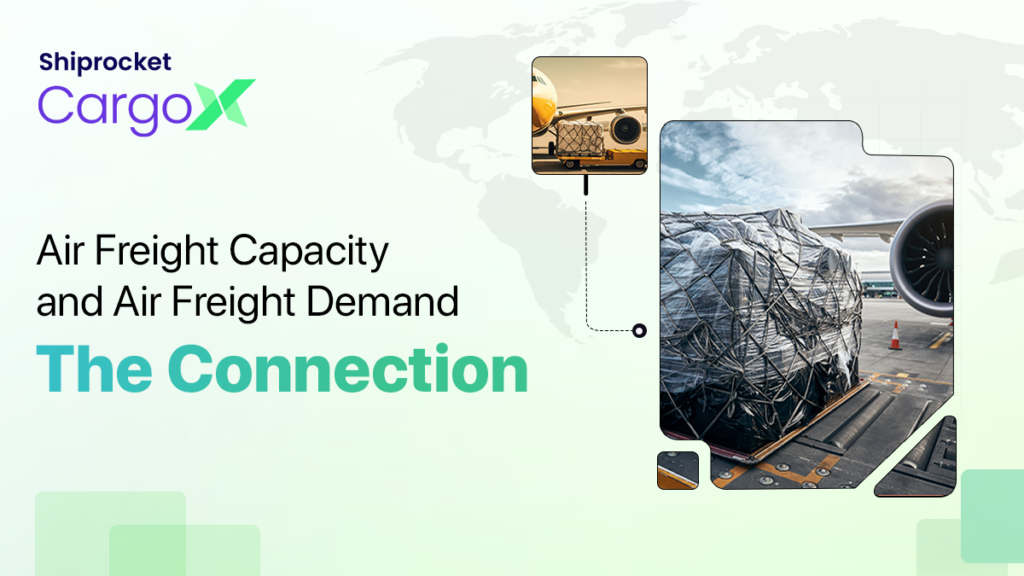Navigating Air Freight: Capacity and Demand Dynamics
- Defining Air Freight Capacity
- Variables Determining Air Freight Capacity
- Varying Air Freight Capacity at Different Locations Around the Globe
- Latest Trends in Air Freight Capacity
- Air Freight Demand: An Overview
- Factors Influencing Air Freight Demand
- Varying Air Freight Demand at Different Places
- Air Freight Demand: Recent Trends
- How Globalisation Shaped Air Freight Capacity and Demand?
- Technological Advancements Augmenting Air Freight Capacity and Demand
- Solutions to Deal with Air Freight Demand and Capacity Issues
- How Government Regulations Impact Air Freight Demand and Capacity?
- How Environmental Regulations Affect Air Freight Demand and Capacity?
- Hurdles Before the Air Freight Industry
- Forecasted Changes in Air Freight Capacity and Demand
- Conclusion
Understanding the specifics of air freight capacity and demand is significant in the constantly evolving world of global transportation and logistics. The purpose of air freight capacity is becoming more and more important as the global economy changes and trade crosses boundaries. In today’s fast-paced world, air freight services are necessary for the reliable and effective transportation of goods.
Air freight capacity, or available cargo or storage space, is the maximum weight an aircraft can carry during a trip when used for air freight services. August 2023 saw a 1.5% year-over-year (YoY) increase in global cargo tonne-kilometers (CTKs), marking the first yearly growth in 19 months since February 2022. The worldwide air cargo demand was 10.8% higher than in 2022, during December 2023. It was +11.5% for overseas operations.
This article examines air freight capacity and air freight demand in detail, including the various aspects that influence them, and the effects these have on the worldwide supply chain.

Defining Air Freight Capacity
The importance of understanding air freight capacity in the realm of logistics and transportation cannot be overstated. The demand for effective and dependable goods and transportation services is greater than ever as the world economy changes continuously. This is where the significance of air freight and air freight capacity comes in.
Air freight capacity is known as the total area of cargo space or storage space available on an aeroplane to transport products. It is the maximum and heaviest quantity of cargo that can be transported on a particular aeroplane in a certain amount of time. Air freight services are provided with different planes, which include:
- Passenger/Commercial aeroplanes: In commercial planes, the products to be shipped are put inside the belly of the plane below the passenger’s area with other goods. The capacity of these planes is approximately 150 cubic meters.
- Cargo-only aeroplanes: Different shipping companies, like DHL, FedEx, etc., have different cargo planes that carry a lot more shipments than commercial planes. The capacity of such planes is approximately 736 cubic meters.
Variables Determining Air Freight Capacity
Some of the significant variables determining air freight capacity are as follows:
- Air freight capacity is directly influenced by the size and type of an aeroplane. The freight area that can be used for shipping is greatly impacted by the differences in the interiors of commercial or cargo aircraft.
- The air freight capacity will be higher on air routes with high demand and frequent flights.
- The air freight capacity and its efficiency can be impacted by laws regulating customs, aerospace restrictions, security, etc.
- Economic conditions are one of the key factors affecting air freight capacity since changes in fuel prices may lead to fewer flights and reduced capacity.
- Various environmental and geopolitical issues, such as trade disputes and political party instabilities, can impact the air freight capacity that is offered in specific locations or routes.
Varying Air Freight Capacity at Different Locations Around the Globe
The air freight capacities in different locations around the globe vary due to different factors. There is no universal solution to the air freight capacity issues of different regions, because of their different laws, regulations, and restrictions. Some of those variables affecting air freight capacity are as follows:
- The air trade routes that are already famous usually have higher air freight capacity because of frequent flights to that region in comparison to other remote locations.
- Different regions around the globe have different laws, customs, and regulations regarding trade and air cargo services, which directly influence air freight capacity.
- Many locations around the globe are becoming growing economies by increasing their trade relations with others. Such regions with strong partnerships and high demand necessitate larger air freight capacity.
- A well-equipped airport with good infrastructure will have more customers.
Latest Trends in Air Freight Capacity
Air freight service is a popular way of transporting goods amongst global traders because it is reliable and delivers goods more quickly than others. The air freight industry is constantly changing and coming up with new trends and developments to meet the demands of customers. Here are some of the latest trends and developments in air freight capacity:
- Digitalisation: The air freight industry has changed tremendously because of the latest automation and integration of digital technologies to improve services. Digitalisation helps in air freight efficiency improvement, real-time tracking, capacity utilisation, space allocation, minimal delays, sensors, etc. According to IATA, digitalisation and automation trends directly boost the capacity of air freight flights.
- Drone technology: With time, the utilisation of drones and other unmanned aerial vehicles for the transportation of goods has increased and directly enhanced air freight capacity. The drone market is expecting an increase in demand in the future for on-site, emergency supplies, and industrial deliveries. It is expected to grow to USD 17.9 billion by 2030 from USD 534 million in 2022
- eCommerce: The demand for air freight capacity is increasing as the eCommerce trade is growing. Big companies like Amazon are also investing in air freight services now to increase air freight capacity and support global traders.
Air Freight Demand: An Overview
Air freight demand refers to the amount and value of goods transported by air freight services. The demand for air freight services depends on a wide range of variables such as technological trends, market dynamics, trading, population, consumer demand, supply chain, eCommerce growth, delivery time, seasons, etc.
Air freight demand also depends on the type of services airlines and airports provide to ensure customers with secured transportation of goods. The latest technological developments and automation trends, like real-time tracking systems, good packing materials, digitised airports, good loading equipment, etc., also contribute to the increase in air freight demand by gaining customers’ trust.
Factors Influencing Air Freight Demand
Air freight demand can increase or decrease depending on various factors. Some of the significant ones include:
- The air freight demand for goods increases when consumers buy products from abroad, which depends on strong economic growth. More people who are willing to buy products from abroad result in increased demand for the transportation of goods through air freight services.
- The continuous growth in eCommerce nowadays is leading to a major increase in air freight demand. Online shopping has connected consumers with global retailers, enabling them to order from any region of the world. This is why eCommerce businesses are investing in air freight services to fulfill customers’ delivery requirements.
- Air freight services are important for international businesses, supply chains, and the export and import of goods from different regions of the globe, which directly increases air freight demand.
- There are many other modes of goods transportation like sea freight, roadways, trains, etc. However, air freight demand is usually high because this mode of transportation is not restrained by conditions like strikes, natural disasters, congestion, low capacity, etc.
- Air freight demand is usually high during the festival season or peak season of the year when there are high orders to transport.
Varying Air Freight Demand at Different Places
Air freight demand is unique in different places because of their different requirements. Some of the significant variables are explained below:
- Regions, where there are higher economic activities such as manufacturing, trading, production, etc., are seen to have higher demand for air freight services.
- A region with connecting routes and networks, an international airport, and air cargo services available will have higher flight frequencies, and the air freight demand will also be higher.
- If a region has a larger population, that will result in more customers demanding the transportation of goods from abroad. The purchasing power of a region increases with population, and air freight services are used in such regions to transport products timely.
Air Freight Demand: Recent Trends
The trends in air freight demand are continuously changing. These changes in demand are influenced by shifts in trading, development in industries, economic growth, technological advancements, etc. Some of the trends in air freight demand include:
- eCommerce: Air freight services are convenient for eCommerce businesses as they provide quick transportation of goods. The continuous growth of eCommerce results in higher air freight demand to transport goods to customers, retailers, distributors, etc.
- Healthcare: The healthcare industry always has a higher demand for freight flights because their transportation requirements are always urgent and time-sensitive. For example, during COVID-19, the air freight demand was higher to distribute vaccines, medical supplies, PPE kits, etc.
- Supply chain: During COVID-19, the supply chain has faced multiple issues due to the lockdown. The demand for air freight services increased that time for transportation of necessities. According to a survey conducted by McKinsey & Company 85% of companies have planned to focus on their supply chain management.
How Globalisation Shaped Air Freight Capacity and Demand?
Globalisation had a great influence on the demand for air cargo service and capacity of air freight, leading to notable changes in the air transportation industry. The popularity of air freight services is evidence of how industries are growing quickly, and the entire globe is becoming closer. The need for air freight capacity is growing rapidly as more businesses expand globally. Air freight services have become a crucial part of global supply chains and trade between countries.
The growth of air freight services highlights how important it is to promote international trade. Globalisation and global trade have supported supply chains and increased demand for air cargo services. Freight flights are famous in trading because they are a flexible mode of transportation that follows strict deadlines and boosts the earnings of businesses. eCommerce businesses depend on air cargo for the speedy and reliable delivery of their products to consumers throughout the globe. It can be said that air freight capacity and demand will remain important in bridging markets and meeting the demands of companies all over the globe.
Technological Advancements Augmenting Air Freight Capacity and Demand
Developments in technology have already changed the way goods are transported from one region to another. Advancements in technology have not only improved the efficiency of air freight services, but they have also helped in increasing their capacity. Some of the recent significant technological advancements include:
- Modern technologies like blockchain, cloud computing, and real-time tracking have increased the reliability and transparency of freight flights.
- New aircraft designs and technologies have improved the freight plane’s capacity, range, fuel efficiency, and ability to carry heavier loads.
- Automation in air freight services promotes decision-making and helps with the routine tasks of freight flights.
- Artificial Intelligence detects risks and failures beforehand through sensors, which reduces the downtime for transportation.
- Machine Learning has eased the task of planning routes as it plans and manages capacity to increase the efficiency of the plane.
Solutions to Deal with Air Freight Demand and Capacity Issues
Air freight demand and capacity issues are impacted by different factors, and there cannot be one solution for all of them. But here are a few common solutions that can be used to deal with air freight capacity and demand issues:
- Sustainable airlines: Airlines need to use sustainable resources for air freight services for their long-term sustainability. Using eco-friendly packaging materials, fuel-efficient flights, low carbon emissions, reducing waste, etc. are some of the long-term solutions that airlines can adopt as sustainable solutions.
- Partnerships and Collaborations: It is always suggested that airlines and companies should invest in multiple trade agreements, different modes of transport, and partnerships with other trading or airline companies. Such partnerships and agreements will help them in the future because they will have alternatives for their freight capacity issues.
- Digitalisation to improve efficiency: Airlines adapting digital developments like cargo management software, sensors, cloud-based management, tracking devices, etc. are solutions to various issues. It improves the transparency and efficiency of air freight services.
How Government Regulations Impact Air Freight Demand and Capacity?
Air freight services in a region are always possible with the support of that region’s government, under its laws and regulations. The air freight demand and capacity are promoted to be used when it meets the safety standards, trading rules, supply chain, market needs, etc. of that region. The government has strict laws to make sure that the goods are transported safely, and the airline has safety management systems, trained staff, and well-maintained aircraft.
Every government has regulations and procedures such as customs, and trading documentation for the import and export of goods. These controls help shipping services enhance transparency in international trade to avoid any risks or illegal activities. Government authorities also assess the maintenance of the aircraft from time to time to know the possible harm it can pose to the environment.
How Environmental Regulations Affect Air Freight Demand and Capacity?
The demand and capacity for air freight services are majorly influenced by environmental restrictions and regulations. The following are some such regulations:
- Freight flights should meet the carbon emission standards and carbon pricing mechanisms imposed by environmental authorities to reduce greenhouse gas production.
- Airport authorities have noise regulations to reduce the noise pollution caused by an aircraft during take-offs and landings. They also have strict rules regarding quieter take-offs and landings, which directly lowers the air freight capacity of the flight.
- A fuel-efficient aircraft is most important to increase sustainability. Airport authorities and environmental regulations encourage airlines to use fuel-efficient planes or use alternative fuels.
Hurdles Before the Air Freight Industry
The air freight industry has faced multiple hurdles that have challenged its ability to grow and work efficiently from time to time. However, it has been a joint effort of different airlines, the air industry, technology people, and other authorities that have helped the air freight industry reach where it is today. Some of the major hurdles before the air industry are mentioned below:
- Fluctuation in fuel prices affects the air freight industry the most because they directly impact the profit, finance, and costs of the airline.
- Meeting the several needs of authorities, such as fuel efficiency, noise restrictions, emission regulations, carbon footprints, sustainability goals, profit, etc., is not feasible for airlines. This leads to a reduced number of flights and less profit for airlines.
Forecasted Changes in Air Freight Capacity and Demand
The changes in air freight capacity and demand are influenced by multiple variables such as technological advancements, authorities, global trading, economic growth, etc. Some of the changes that can be forecasted are as follows:
- As the eCommerce business is growing efficiently, it is safe to predict that online businesses will continue to grow by making air freight services a reliable and quick transportation option.
- Supply chain management can be digitised in the future, enabling people to use air freight services efficiently.
- The global trading activities of sectors like automotive, electronics, healthcare, manufacturing, production, etc., will be increased resulting in a high demand for air freight services.
Conclusion
It can be said that there will be significant changes in the capacity and demand of the air freight industry in the years to come. Companies and airlines will face a world which is complex but full of opportunities. The expected changes in air freight demand and capacity highlight the need to take proactive measures and make wise investments to adapt to changing market conditions. Understanding the future challenges and realising the full potential of air freight industries will depend on how airlines integrate sustainability, use digitisation, and create partners. Air freight capacity continues to be essential for enabling easy trade movements and satisfying the needs of a world that is changing quickly. Sellers should be mindful of choosing a trustworthy logistics solution provider like CargoX for their international air cargo shipping. Their fast and reliable transportation and tailor-made air freight shipping help eCommerce businesses provide timely and secure delivery and satisfy their international customers.
You may direct toward a future wherein air freight capacity acts as a catalyst for economic growth, association, and wealth on a global level.




